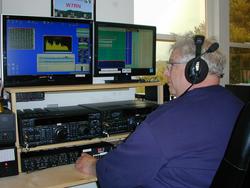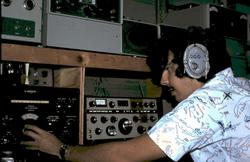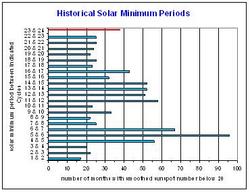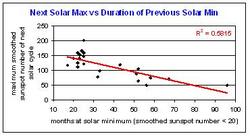 January 7, 2009 Editor: Ward Silver, NØAX | ||||||
IN THIS ISSUE
NEW HF OPERATORS - THINGS TO DO The upcoming North American QSO Parties are great, friendly ways to dabble in HF contests. The exchange is simple--your name and your state or province or country. All North American stations can take part, including those in the Caribbean and Central America. Since you can work stations once per band, be prepared for a quick QSY if asked! These are terrific ways to work on your 5BWAS award! BULLETINS There are no bulletins in this issue BUSTED QSOS Apologies to the RTTY contesters for leaving the ARRL RTTY Roundup off the Contest Summary list below, although it was in the Contest Rules section. From all reports, it was the biggest turnout ever for this rapidly growing contest! As misidentified in the last issue's photo caption, the Four Manualeros include not K6RO, but N6RO, everybody's favorite banjo-playing multi-multi maven. CONTEST SUMMARY Complete information for all contests follows the Commentary section January 10-11
January 17-18
NEWS, PRESS RELEASES, AND GENERAL INTEREST When this newsletter is emailed, it will still be January 6th in the United States--the 170th anniversary of the 1838 demonstration of Samuel Morse's telegraph system for the first time at the Speedwell Iron Works in Morristown, New Jersey! In May 1844, from a building just off Washington, DC's National Mall, Morse sent the first official telegram over the first telegraph line to Baltimore, MD, with the message: "What hath God wrought!" Lots more about Morse's invention can be found on the History Channel's Web site. (Thanks, Perry WY1O) Canadian hams may be heard using special prefixes until 28 February as part of the International Year of Astronomy. This event commemorates Galileo Galilei's first look through an optical instrument towards the heavens.
(Thanks, Malcolm VE7DAO) The Mt Airy VHF Radio Club, better known as the "Packrats" held a "Tech Nite" at a recent meeting. Paul W2PED, Gary WA2OMY, Warren WB2ONA, and Phil K3TUF led a team of technicians to test equipment that the members brought in. Test equipment included things like signal generators, a spectrum analyzer, and noise figure analyzers, but the most important ingredient was the skill and know-how of the technicians. Whether the equipment was repaired or just checked out, everyone agreed that this was a very valuable exercise. Why not line up the technical wizards in your club and have your own Tech Nite? (from the January 2009 Mt Airy VHF Radio Club Cheese Bits) The Southeastern VHF Society's 2009 Conference will be held in Charlotte, SC over the weekend of April 24th and 25th. One of the many highlights of the event is the design competition with cash prizes and an award for the winner. Take a look at these photos to see how much fun folks are having! If you have an interest in VHF+ contesting and operating, this is an event to put on your calendar. (Thanks, Dexter W4DEX)
Jeff K8ND has been maintaining a "Known Bad Frequencies" operating aid for a number of years. It shows frequencies that are known locations for persistent QRM from broadcast birdies and other fixed-frequency sources. He would particularly like to add information on such frequencies in Asia and Europe. If you're contemplating an expedition or CQing to specific areas of the world during your night-time contest hours, this would be an excellent resource to have bookmarked. The December 2008 issue of Contest Club Finland's PileUP! magazine will be placed on-line on 13 January. (Thanks, Ilkka OH1WZ) If you're trying the new D-STAR radios, such as Icom's IC-2820 or IC-92AD, you know that getting all the information programmed into the radio can be tedious. John K7VE notes that AE7Q has written a nice little utility that takes CSV files (such as from a spreadsheet or database) and creates ICF files used by Icom programming software. The NWHAM Web site offers a convenient way to get the frequencies (and for analog FM, the access tones) into the CSV file easily for systems in the Western US and most of Canada. Enter your search criteria and from the list of repeaters, select Export->Icom->D-STARcomm and a CSV file will be created. If you register, you can also send the site updates on information contained in the database. Special thanks to the Web site administrators! Long accustomed to dealing with third-party rules, encryption of information sent via amateur radio is new territory to contest operators. In the face of new digital technology, rulings regarding digital links being used during emergency communications have clarified the long-understood ruling of "No encryption" to "Encryption is allowed if...". These two articles have more information: "Data Encryption is Legal," by N2IRZ, CQ Magazine, Aug 2006 "HSMM and Information Security," by K8OCL, CQ-VHF, Fall 2004 (Thanks, Steve KB9MWR) Antenna system builders will want to look over a pair of new products from Array Solutions. The Bias-T MASTER is a 1.8-54 MHz stand-alone weatherproof unit that permits the application or extraction of dc power and control voltages of up to 1.5 amps via your coaxial cable feed line. That eliminates the requirement for and expense of an extra dc power cable. The Bias-T MASTER can be used for remote powering of remote RF switches, mast-mounted preamps or remote-mounted autotuners. It easily handles full legal limit power. For the lower-current needs of mast-mounted preamps or other low current devices, the Array Solutions Bias-T PLUS (on the same Web page) is rated at up to 400 mA of dc current and full legal RF power from 1.8 - 148 MHz. (Thanks, Jay WX0B)
Tom K1KI alerts us that after many years of providing free Web hosting and other services to hams, Al K3TKJ is bowing out of QSL.net. (Thanks, Al!) The site is moving to Scott KA9FOX's QTH.com Web site. (Thanks, Scott!) From one Q-signal to another...how apropos! A member of the Yahoo Rockmite group made this calculator to figure "Miles (or Km) / Watt" for QRP operators. You just enter your power level and the calls of each station, press locate beneath each--and--bingo! (Thanks, John K7HV) RFI is everywhere! Check out what the Green Bank's radio telescope has to deal with. (Thanks, Howard N7SO) Since it's more likely that we'll be reading about sunspots in 2009 rather than experiencing them, here's an article about the current sunspot drought. (Thanks, Mark K6UFO) Web Site of the Week-Clocks of the 24-hour variety are popular gifts for hams and one of the most accurate clocks is the type synced to the VLF signals of WWVB. Considering that the wavelength of a 60 kHz signal is 5000 meters, how do they do it? Take a tour of the station online and marvel that those tiny clocks hear the signal so well! (Thanks, Rod AI7NN) WORD TO THE WISE The word to the wise is "+". Huh? On some spotting network monitoring programs, a "+" after the call sign (or some other similar symbol) means that station is a Logbook of the World User! Some stations prefer to work LOTW-using stations because of the ease of QSLing. And that's a definite plus! (Thanks, Benny K5KV) SIGHTS AND SOUNDS This Web site of K6DPZ's collection of vintage SSB gear is certainly generating some buzz! And you thought YOU had a lot of equipment? (Thanks, Arnie N6HC) As if the three-element rotating 160-meter Yagi isn't enough to shrivel your coax, here's a video presentation on the OH8X station's remote operating capabilities. (Thanks, Dave N2NL) Updated photos by Dayton photographer of yore K8CX of the K3LR team during the 2008 CQ WW contests have been posted on the K3LR Web site. Lots of improvements at K3LR in 2008 will keep those operators busy, too! RESULTS AND RECORDS Julius N2WN reports that the final results of the 2008 Russian DX Contest have been published. This is an important qualifying contest for WRTC-2010 (now next year!) and the top European operators, in particular, will have made big efforts for a top score. Results of the 2008 Ukrainian DX Contest are now available online. If you have any question regarding your log or UBN report please send an email to urdxc@ukr.net. (Thanks to the URDXC Committee) The results of the 2008 EU HF Championship & Slovenian Contest Club RTTY Championship are now ready and available on the SCC home page. "As the previous years we want results to be transparent--all UBN files are public and open to all, accessible with the "click" on the desired call sign in the results listing." (Thanks, Robert S57AW) OPERATING TIP Many phone operators like to use a foot switch instead of VOX. Why? Using a manual switch lets you have complete control over when to key the transmitter and, more importantly, when not to! Give it a try and see if after a little while it doesn't seem just as natural as VOX. Another tip--mount the switch on a piece of thin plywood or fiberboard so that your foot can hold the switch in one position. Chasing the switch around while trying to operate in a contest can drive you crazy! TECHNICAL TOPICS AND INFORMATION Glen K9STH reminds us of an old and useful shack junk box trick, if you need some well-insulated wire to carry high-voltage power, remove the jacket and shield braid from some RG8/U or RG213/U coaxial cable. These cables have a voltage rating of several thousand volts. Do not use cable with a foamed center insulation as that material is susceptible to nicks and crimps and moisture ingress, lowering its insulating properties. Neil K7WK discovered a source of online technical books, downloadable in PDF format. Some of these are readable on other sites, but having the PDF version on one's computer is often more convenient. A note, when reading a book online or downloading it, please respect copyrights. If the site owner has posted copyrighted material, ask them to remove it and notify the book's author or publisher. When using an automated decoder, such as CW Skimmer, errors in receiver calibration can cause duplicate spots in logging software band maps and being off-frequency a bit when "clicking through" to the spot. Pete N4ZR observes that SoftRock receivers can be calibrated with sufficient accuracy simply by listening to signals on your regular transceiver and then adjusting the center frequency in Skimmer until the beat notes and frequency readouts agree. In SoftRock-IF mode, you can do the same using the "Audio IF" frequency. With the SDR-IQ, you can either use Skimmer's calibration routine or the one in Spectravue. Pete recommends using the Spectravue calibration to avoid double errors of applying both Softrock and Spectravue calibrations.
Yes, you CAN use your HF2V for 160 meters as described in this article by VE6LB in the Society of Midwest Contester's Black Hole newsletter. (Thanks, Rick W4PC) A popular Top Band antenna array that can be erected with a single (albeit tall) central tower or tree is the Lazy-V array, described by K3LR in the August 1994 issue of QST. ARRL members can use the new ARRL Periodicals Archive Search (you must sign in to see the link) to view the article online. (Thanks, Joe W4TV) All True Electronicers know of the infamous darkness emitting diode--in fact, we've all probably created a few in our day. But do you know the theory behind darkness devices? (Thanks, Thom K3HRN) Owners of Ford vehicles that are considering mobile operation may want to bookmark Ford's own EMC Web site. Ford sells lots of cars and trucks to fleet operators, many of which then install two-way radios. There are also related links to other EMC resources on the page. Ask your local dealer about radio installation guides and kits, too. (Thanks, Eric VE3GSI) Who knew that light bulb manufacturers were conspiring to provide amateurs with a wonderful and ubiquitous source of components for new transmitter projects? Is the CFL the new 807? Take a look at this great project to reuse the innards of a dead (or not-so-dead) CFL bulb! This tiny transmitter has also been picked up by Make magazine's online publication, as well! (Thanks, Tad K7RA) Dimmer switches--more accurately, dimmer controls--can be an awful source of RFI. There are models available with RFI suppression, though. When shopping at the hardware store, read the box carefully and be sure to select one with the filtering. Freedom from interference is well worth the additional cost (up to a 50 percent premium). (Thanks, Bob N2SCJ) Everybody needs to keep a skin depth calculator handy. The Microwaves 101 Web site is full of other good stuff, too! (Thanks, Jim W6RMK) Technical Web Site of the Week-- Two excellent Web sites are featured this week. The first is the home of Wes W7ZOI, author of Introduction to RF Design, co-author of Experimental Methods in RF Design, and designer of many rigs and radio circuits. The site is well-stocked with articles and designs for your browsing and project planning. If your tastes run to the microwave part of the spectrum, check out the web site of Jim W6PQL. Jim has presented loads of projects aimed at 23 cm "and up", so if you are thinking about extending your VHF+ contesting to those high-point-value bands, you might want to start here. CONVERSATION Where Is Solar Cycle 24 Headed? WorldRadio Propagation columnist and frequent contributor to ham radio publications, Carl contributed this short article on the much-anticipated and long-awaited Cycle 24. Isn't this better than another exhortation to take on New Year's resolutions? Enjoy! - 73, Ward N0AX There are more than 50 predictions for Cycle 24 in the scientific community. These predictions are based on a variety of models (precursor, neural network, spectral, and others), and range from a low smoothed sunspot number of 40 to a high smoothed sunspot number of 185. With so many predictions, it's obvious that our understanding of the physical processes in the Sun that make solar cycles is lacking. Hopefully scientists will gain additional knowledge when Cycle 24 is over to better forecast future cycles. But before we even think about where Cycle 24 is headed, we need to emerge from the current solar minimum period. Looking at all historical data tells us that the average duration at solar minimum (based on my definition of the number of months when the smoothed sunspot number is below 20) is around 37 months.
Cycle 23 descended through a smoothed sunspot number of 20 in February 2006 and the latest data indicates a smoothed sunspot number of around 5 for June 2008, so at the present time we're just approaching the average duration of a solar minimum period. Whoa, just approaching the average - that's depressing, isn't it? The data also tells us that there are eight other solar minimum periods that are longer than what we're experiencing. Thus we have quite a way to go before this solar minimum period sets any record (by the way, the record is 96 months for the period between Cycle 5 and Cycle 6 based on my definition). It's interesting to note that the solar minimum periods in our lifetime (in fact, beginning with the minimum between Cycles 17 and 18) have been around 24 months - much less than the historical average. So we've been spoiled by shorter than average solar minimum periods, and when something approaching the average comes along we naturally wonder if it's unusual. Based on all historical data, we are not experiencing anything unusual.
Another interesting fact that comes out of the historical data is the correlation between the length of the solar minimum period and the maximum smoothed sunspot number of the next cycle. It shows a trend of smaller cycles following longer solar minimum periods. If this solar minimum period ends up around the average of 37 months (where it appears to be headed), then it suggests that Cycle 24 is headed towards being an average (or even below average) cycle. This certainly contradicts the very high smoothed sunspot number predictions made by several scientists (for example, by Dr. Dikpati at The University Corporation of Atmospheric Research). But note that we only have 22 data points, which is a very small sample of a process that has likely been going on for thousands of years. So anything could happen - we'll just have to wait and see what Cycle 24 does. CONTESTS An expanded, downloadable version of QST's Contest Corral in PDF format is available. Check the sponsor's Web site for information on operating time restrictions and other instructions. HF CONTESTS 070 PSKFest--Digital, from Jan 10 0000Z to Jan 10 2400Z. Bands (MHz): 3.5-28. Exchange: Call sign, RST, S/P/C . Logs due: Feb 10. Rules Hunting Lions In the Air--Phone,CW,Digital, from Jan 10 0000Z to Jan 11 2359Z. Bands (MHz): 1.8-28. Exchange: RS(T), serial or name, club name, district. Logs due: Feb 28. Rules MI QRP Club Jan QRP Contest--CW, from Jan 10 1200Z to Jan 11 2359Z. Bands (MHz): 1.8-28, 50. Exchange: RST, S/P/C, MI QRP nr or power. Logs due: Feb 11. Rules Midwinter Contest--Phone,CW, from Jan 10 1400Z to Jan 10 1800Z and Jan 11 1000Z to Jan 11 1400Z. Bands (MHz): 3.5-28. Exchange: RS(T) and serial. Logs due: Feb 15. Rules North American QSO Party--CW, from Jan 10 1800Z to Jan 11 0600Z. Bands (MHz): 1.8-28. Exchange: Name, S/P/C. Logs due: Jan 25. Rules DARC 10 Meter Contest--Phone,CW, from Jan 11 0900Z to Jan 11 1059Z. Bands (MHz):28 Exchange: RS(T), serial, DOK code. Logs due: 3 weeks. Rules http://www.darc.de/referate/dx/fedcz.htm Feld-Hell WAS Sprint--Digital, from Jan 17 0000Z to Jan 17 2359Z. Bands (MHz):1.8-28 Exchange: RST, Feld-Hell number, QTH. Rules International United Teenager Contest--Phone,CW, from Jan 17 0600Z to Jan 19 1400Z. Bands (MHz):3.5-28 Exchange: RS(T) and age or "RT". Logs due: 30 days. Rules UK DX RTTY Contest--Digital, from Jan 17 1200Z to Jan 18 1200Z. Bands (MHz):3.5-28 Exchange: RST and serial. Logs due: 30 days. Rules HA DX Contest--Phone,CW, from Jan 17 1200Z to Jan 18 1200Z. Bands (MHz):1.8-28 Exchange: RST, serial. Logs due: 30 days. Rules North American QSO Party--Phone, from Jan 17 1800Z to Jan 18 0600Z. Bands (MHz):1.8-28 Exchange: Name, S/P/C. Logs due: Feb 3. Rules Locust QSO Party--CW, from Jan 21 0200Z to Jan 21 0300Z. Bands (MHz): 3.5-7 Exchange: Name, QTH or 'DX'. Logs due: Jan 31. Rules VHF+ CONTESTS MI QRP Club Jan QRP Contest--CW, from Jan 10 1200Z to Jan 11 2359Z. Bands (MHz): 1.8-28, 50. Exchange: RST, S/P/C, MI QRP nr or power. Logs due: Feb 11. Rules ARRL January VHF Sweepstake--Phone,CW, from Jan 17 1900Z to Jan 19 0400Z. Bands (MHz):50+ Exchange: Grid square. Logs due: Jan 187. Rules LOG DUE DATES 7 January through 20 January January 8 - ARS Spartan Sprint, email logs to: spartansprint@yahoo.com, paper logs and diskettes to: (none). Rules January 9 - AGB-Party Contest, email logs to: eu1eu@mail.ru, paper logs and diskettes to: Igor "Harry" Getmann, EU1EU, PO Box 143, Minsk 220005, BELARUS. Rules January 12 - DARC Christmas Contest, email logs to: xmas@dxhf.darc.de, paper logs and diskettes to: (none). Rules January 13 - ARRL 10-Meter Contest, email logs to: 10meter@arrl.org, paper logs and diskettes to: 10 Meter Contest, ARRL, 225 Main St, Newington, CT 06111, USA. Rules January 15 - CQ Worldwide DX Contest, CW, email logs to: cw@cqww.com, paper logs and diskettes to: CQWW CW, CQ Magazine, 25 Newbridge Road, Hicksville, NY 11801, USA. Rules January 15 - OK DX RTTY Contest, email logs to: okrtty@crk.cz, paper logs and diskettes to: Czech Radio Club, OK DX RTTY Contest, PO Box 69, 113 27 Praha 1, Czech Republic. Rules January 15 - NA High Speed Meteor Scatter Winter Rally, email logs to: wa5ufh@ykc.com, paper logs and diskettes to: (none). Rules January 18 - RAEM Contest, email logs to: rw4wr@srr.ru, paper logs and diskettes to: RAEM Contest, PO Box 3945, Izhevsk 426011, Russia. Rules January 20 - Croatian CW Contest, email logs to: 9acw@9acw.org, paper logs and diskettes to: Hrvatski RadioAmaterski Savez, for Croatian CW Contest, Dalmatinska 12, 10000 Zagreb, Croatia. Rules January 20 - Russian 160-Meter Contest, email logs to: contest@radio.ru, paper logs and diskettes to: Radio Magazine, 10 Seliverstov per, 107045 Moscow, Russia. Rules ACKNOWLEDGEMENTS ARRL Contest Update wishes to acknowledge information from WA7BNM's Contest Calendar and SM3CER's Contest Calendar. | ||||||











